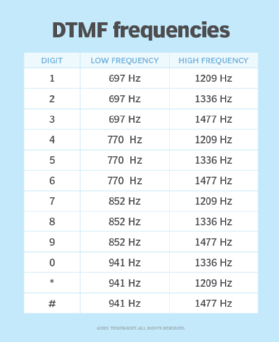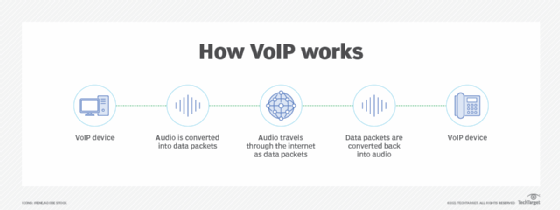DTMF (dual tone multi-frequency)
What is dual tone multi-frequency (DTMF)?
Dual tone multi-frequency (DTMF) is the sounds or tones generated by a telephone when the numbers are pressed. These tones are transmitted with the voice channel.
DTMF is used to control automated equipment and signal user intent, such as the number they wish to dial. Each key has two tones at specific frequencies.
How dual tone multi-frequency works?
DTMF technology works by having the handset generate tones at specific frequencies and playing them over the phone line when a button is pressed on the keypad. Equipment at the other end of the phone line listens to the specific sounds and decodes them into commands.
These commands are typically used to dial a phone number to call but can also be used to signal phone control commands or control remote equipment, since the control tones are played on the same channel as the voice signal. It is an in-band signaling system; this is different than out-of-band systems, such as Signaling System 7.
DTMF specifies eight different tones. They are divided into a high group and a low group. Each key press corresponds to two tones -- hence the name dual tone -- one from the high group and one from the low group. This allows for 16 total keys.

These keys are specified as the numbers 0 through 9, * (asterisk or star), # (pound, hash or octothorpe) and the letters A through D. The letter keys are not generally used and are omitted from the vast majority of consumer telephones. The telecommunications industry chose two simultaneous tones for each key to eliminate the possibility of the human voice triggering the system.
DTMF history and replacement of pulse dialing
Before DTMF, telephone systems used pulse dialing to signal numbers. In pulse dialing, the connection between the handset and the central switch board is disconnected and reconnected rapidly. This was accomplished with a rotary dialer that would interrupt the connection as it spun. It is also called loop disconnect. This is similar to sending Morse code via telegraph by making and breaking an electrical connection. Pulse dialing has many drawbacks that led to the development of DTMF:
- Pulse dialing is a slow process as it takes time to make and break the connections.
- Bigger numbers would take longer to dial with a rotary telephone; this is why more prestigious area codes in big cities have small numbers and many lower-population suburbs have larger digits in their area codes.
- Pulse dialing limited the maximum distance from the handset to the switchboard and could not be used for long-distance dialing.
- It also required a direct electrical connection from the handset to the switchboard.
- Pulse dialing control systems were also complicated to build and maintain with many banks or magnetic relays and counters.
The telecom industry developed multi-frequency signaling (MF) as a forerunner of DTMF. It uses the same principles of DTMF but was only used by long-distance operators to signal other switchers. MF proved the reliability and ease of use of the underlying technology, so DTMF was developed for consumer use.
DTMF, developed by Bell System, was introduced for public use on Nov. 18, 1963. It is known by the trademark Touch-Tone and was quickly accepted as a standard and adopted globally.
DTMF in digital and VoIP systems
DTMF was initially developed using analog electronics. The original systems would use tuned coils with taps at appropriate locations to generate the correct tone. Modern telephones use single chip integrated circuits to generate the tones.
Pure voice over Internet Protocol (VoIP) systems do not natively use DTMF for signaling. VoIP systems use Session Initiation Protocol to signal intent and dial. In order to integrate with legacy systems and for wide interoperability, most VoIP systems also include DTMF capacity through control trunk lines or, for example, dial-in systems. They may also accept DTMF on the inbound stream if a lossless encoder is used.

Modern cellphones also do not use DTMF for dialing, as they are purely digital systems. The entire phone number to call is stored and sent to the cell tower base station as part of the dialing process, and therefore, DTMF tones are not used. Once connected though, cellphones can generate DTMF tones for legacy phone systems.
Other users of dual tone multi-frequency
The ease of use and ubiquity of DTMF have led to its widespread use. Remote equipment can have a phone line attached with a DTMF decoder to accept commands to activate or deactivate it. Military phones use the additional letter keys to prioritize calls. Ham radio operators may use DTMF tones to control two-way radios or repeaters.
Company phone systems can use DTMF signals to navigate a telephone menu. A company may also use DTMF to accept credit card transactions over the phone. Payphones that accept credit cards use DTMF to transmit card data. Voice-activated menu systems are quickly replacing these systems, however.
DTMF uses audio frequencies, so key presses can be used to play recognizable melodies. Since each button makes two tones and they do not directly line up to standard musical notes, it's not an exact correlation, though.







